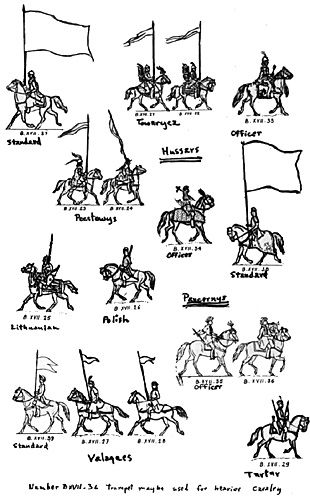
This included the heavy armored cavalry (the famous winged hussars) the medium armored cavalry (the "pancerni" or "cossacks" which must not be confused with the Zaporagne Cossacks and the light cavalry (polaques and mounted arquebusiers of Colonel Lisows'ki from 1610 to 1650, tartars, valaques, etc.)
[Ed.: Remember Yul Bryner? Actually the Zaporogne Brotherhood doesn't seem to have done as well in history as in technicolor]
1.) Hussars of the Royal Companies wore red and blue. Other companies wore the colors of their captains or no particular uniform at all.
2.) The Pancerno's followed the same pattern as the hussars.
3.) Light Horse:
Lizowici: Numerous documents have them dressed in all manner of clothing, including captured garb. On the other hand certain pictures represent them in green with red and black doublets, officers In white with red doublets. During the 30 years war they served with the Imperialists. They seem to have been very numerous (5000 to 6000) with marked specialization by company: arquebusiers, lancers, curassiers . . .
Tartars: Contrary to general belief, they were admirably organized and disciplined. They wore black with dark fur borders and a crimson cap, often fur trimmed.
Valaques: This was the normal type (by recruitment) of light cavalry. They were more than 20,000 in all. A painting contemporary with the siege of Vienna (1683) shows the first charge of the Valaques against the Janissaries. The Valaques are dressed in bright red from head to toe. Only the doublet of the Zupan being light blue. The silk banners are blue trimmed yellow. Other paintings show the valaques in light grey with cap and trim of yellow. Finally one hears of a white uniform with trousers and cap of light blue.
Zaparoque and other irregular cavalry had no particular uniform.
The Polish, Lithuanian, and Hungarian cavalry was organized along feudal lines: each noble cavalryman (Towarczis) was accompanied by his armed valet (Pacholek or Pocztowi), a soldier like himself, who fought in the second line (or the second rank.) A company ("chorayiew" or banner) included 1 captain (rotmistr), 1 lieutenant, 1 trumpet, 1 cornet, 50 cavaliers of noble birth and the "pacholki" of all the "lords", i.e., 54 in all 108 cavalryman. Out of service the Towarycyz were the equal of the officers. All wore the same uniforms, if there were uniforms, except that the officers and noble cavallers had the most beautiful (Ed. exotic) skins and gold decorations. They wore the skins of tigers or leopards while their valets [Ed.: squires in western chivalry] could only decorate themselves with wolf or bear skins. Finally, in principle, the lance was reserved for nobles. In fact the pocstowi are often shown with the lance. On the other hand towards the middle of the XVII Century they took the carbine for their first duty which was, in the field, to scout and skirmish with the enemy's forragers. In the charge they returned to form the second rank.
On campaign, several companies regardless of arm were formed In a "Pulk". In peacetime the "Pulk" was dissolved, each company regaining its independence. The Idea of the regiment does not appear in the troops organized on Polish lines until around 1690.
The Polish Pancernis usually did not carry the lance, using at close quarters a fairly short saber of oriental style. The Pancernis of Lithuania on the other hand, carried the lance as well as an assortment of other weapons.
The Pocztowi (second rank hussars) are sometimes shown with the "wings" of the noble first rank.
More 17th C. Polish Army
Back to The Armchair General Vol. 2 No. 2 Table of Contents
Back to The Armchair General List of Issues
Back to MagWeb Master Magazine List
© Copyright 1969 by Pat Condray
This article appears in MagWeb (Magazine Web) on the Internet World Wide Web. Other military history articles and gaming articles are available at http://www.magweb.com
